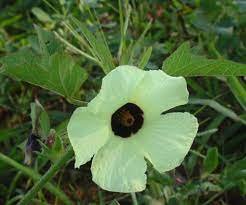NAME: Hibiscus asper
COMMON NAMES: sapa,Ireagu,Dangiraa
LOCAL NAMES: Bush roselle,thorny roselle,water hemp
MORPHOLOGICAL DESCRIPTION: Hibiscus asper is a species of hibiscus with distinctive features:
Leaves: The leaves are typically green, simple, and alternate, with a serrated or toothed margin.
Flowers: Hibiscus asper produces large, showy flowers with five petals. The color and size of the flowers can vary, but they often have a prominent central stamen.
Stem: The stem is typically green and can vary in size and branching patterns depending on the individual plant.
USEFUL PART(s): Different parts of Hibiscus asper may have uses, primarily in traditional and herbal applications.
Leaves: In some regions, the leaves are used in traditional medicine for their reported health benefits.
GENERAL USES:
Traditional Medicine: The leaves of Hibiscus asper are used in some traditional herbal remedies. They are believed to have medicinal properties for various health issues.
Ornamental: While not as commonly grown for ornamental purposes as some other hibiscus species, it may be cultivated for its attractive flowers.
GEOGRAPHIC DISTRIBUTION: Hibiscus asper is native to tropical and subtropical regions of Africa and can be found in various countries on the continent.
WHY IS IT GREEN? The green color of the leaves, like in most plants, is due to the presence of chlorophyll. Chlorophyll is the pigment responsible for capturing light energy and converting it into chemical energy through photosynthesis, allowing the plant to produce its own food.
ENVIRONMENTAL IMPACT: Hibiscus asper, like other hibiscus species, can contribute to local biodiversity by providing nectar for pollinators and offering habitat and food for various wildlife. Its exact environmental impact may vary based on factors such as the extent of its cultivation and local ecological conditions.
FUN FACT: Hibiscus plants, including Hibiscus asper, have been used for centuries in traditional medicine and cultural practices in many parts of the world. They are appreciated not only for their beauty but also for their potential medicinal properties.
Further Reading: To learn more about Hibiscus asper, you can explore ethnobotanical studies, traditional medicine resources, and botanical references. Additionally, for information on its ecological impact, consider researching studies on its interactions with local ecosystems.
CONTACT NO: +2348111138444


